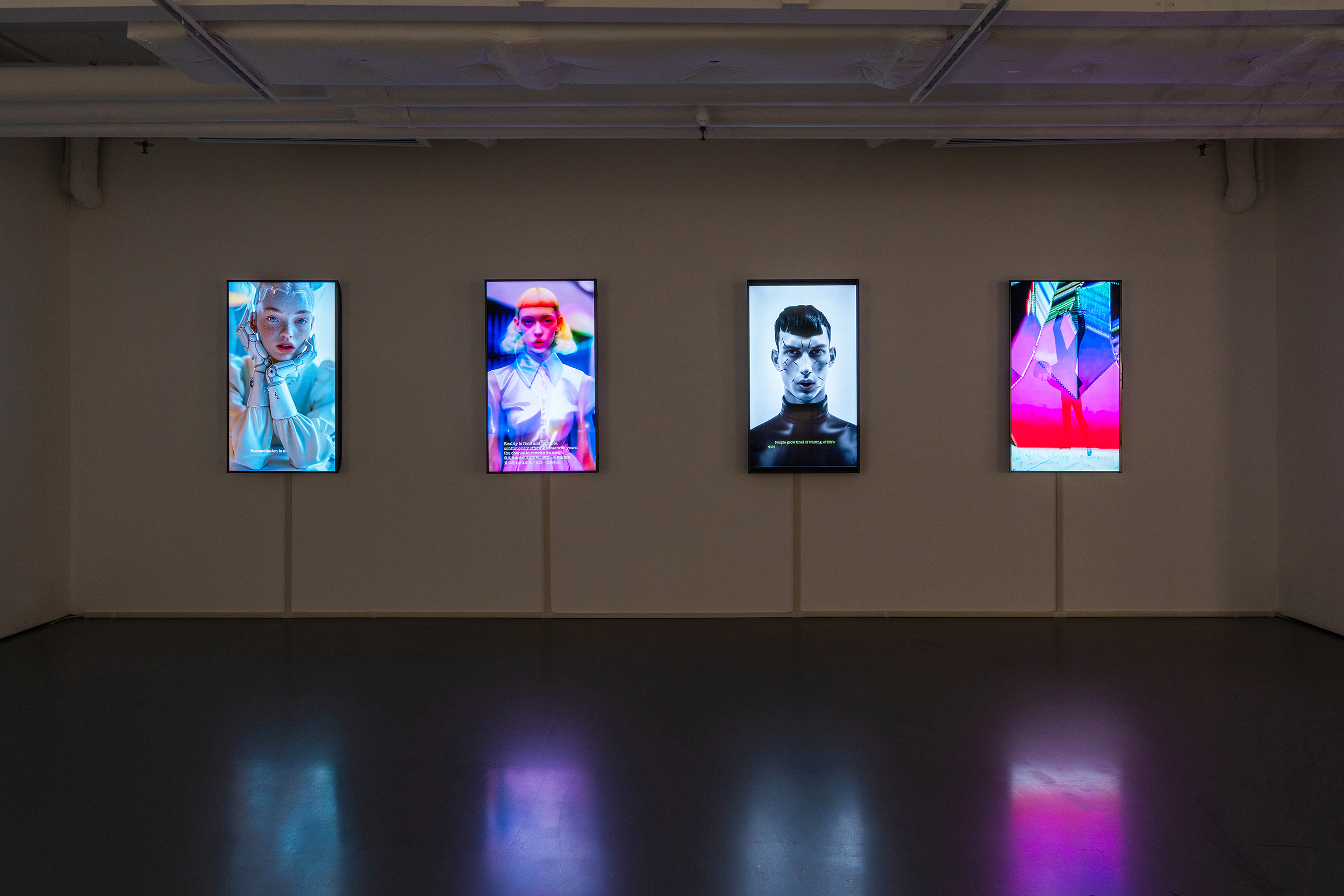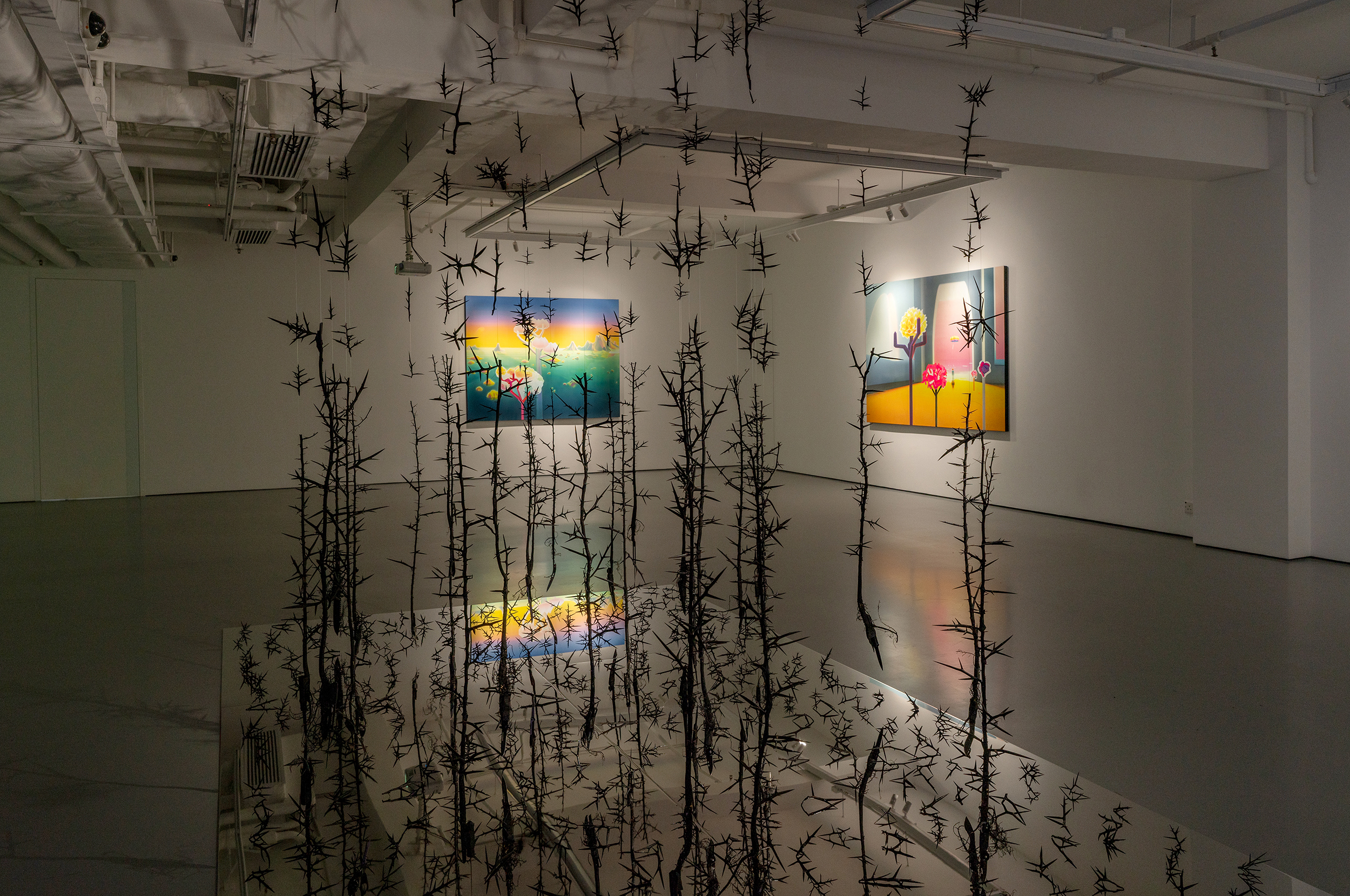Lov-Lov Proposes “Everything Is Unreal Until It’s Not”
By Camilla Alvarez-Chow

Installation view of LOV-LOV‘s "Everything Is Unreal Until It’s Not" at De Sarthe Gallery, Wong Chuk Hang, Hong Kong, 2024. Courtesy De Sarthe Gallery.
Mar 23–Apr 27
Lov-Lov: Everything Is Unreal Until It’s Not
De Sarthe
Hong Kong
Artificial intelligence was once the realm of science fiction. Now that the future has arrived, it has led artists to harbor a disdain for AI’s generation of iterative works that threaten their own creative livelihoods. Some, however, view AI as another tool. Such is the case with New York-based artist Lin Jingjing, who uses the technology to convey the disillusionment that AI inspires. Through her digital alter ego “Lov-Lov,” the artist has created artworks that range from painting to videos and installations for “Everything Is Unreal Until It’s Not” at Hong Kong’s De Sarthe gallery, a show that, fittingly, sought to explore the dichotomy of “the idyllic and the unsettling” when our lives are immersed in AI fantasies.

Installation view of LOV-LOV’s I am the Metaphor, 2024, single-channel video with sound: 1 min. Courtesy De Sarthe Gallery.
The exhibition opened with a cacophony of voices talking over each other, intermingled with light acoustic music. One of these voices is that of Lov-Lov herself, as her video work I am the Metaphor (2024) was situated directly outside the entrance. I am presents an AI-generated figure dressed in a pink blazer adorned with a large amber butterfly, with a chrysanthemum sprouting from it. The ambiguous entity declares in a monotone voice that they “need to obtain something ineffable through detachment and estrangement, rather than stating or depicting anything known.” The convoluted statement, composed by existing texts to mimic AI, sets the tone for the rest of Lov-Lov’s uncanny and absurd showcase, where the feelings of “detachment and estrangement” lingered.

Installation view of (from left to right) LOV-LOV’s There are No Safe Games, Inconvenience, All Promises are Experiments, and Why Should One Tell the Truth, all 2024, single channel video: 3 min 7 sec; 3 min 6 sec; 33 sec; 3 min 11 sec. Courtesy De Sarthe Gallery.
The uniform placement of four videos on a wall introduced a sense of chaos. Each of the artworks—There are No Safe Games, Inconvenience, All Promises are Experiments, and Why Should One Tell the Truth (all 2024)—depict a different generated AI model of varying appearances, although all share Caucasian, doll-like features. In Inconvenience, the AI model with platinum-blonde micro bangs, baby-blue eyes, and rouge lips throws out empty-logic statements such as, “You can only linger between wanting to remember and forget [sic].” The figure’s appearance reflects how Eurocentric beauty ideals are amplified by social media algorithms, but her speech demonstrates that these obsessions are only pixel-deep. Nonsensical attempts at philosophy capture AI’s horrible failings at describing human experiences, while the psychedelic colors and effects add to the fatigue of trying to decipher any of it. The combination of unreal voices and aesthetics is overstimulating and claustrophobic, and any effort at trying to understand the artificial constructs becomes futile.

LOV-LOV, Blossoms of Spring, 2024, acrylic and airbrush on canvas 148.5 × 197 cm. Courtesy the artist and De Sarthe.
Lov-Lov also produced five acrylic on canvas paintings depicting AI-generated landscapes, faithfully recreated in material form by Lin. Featuring saccharine colors of cyan, pink, and yellow, the works each show a lone figure gazing at polyhedral trees and distant mountain ranges set apart from vaguely modern architectures. Reminiscent of Romantic-era paintings of the sublime, Lov-Lov’s paintings portray humanoid avatars as they confront vast, empty spaces between artificial-looking renderings of natural forms, suggesting the missing textures and depth of virtual worlds.

Installation view of LOV-LOV‘s _Everything Is Unreal Until It’s Not_, 2024, branches, thorns, blades, knives, stainless steel mirror, dimensions variable. Courtesy De Sarthe Gallery.
At the center of the gallery is the installation Everything Is Unreal Until It’s Not (2024), which consists of thorny black branches hanging from the ceiling by transparent nylon strings, tied to objects that typically denote violence: combat knives, blades, and scissors. The work is reflected back on itself by a stainless-steel mirrored floor. The only work in the space that is organic-looking and tangible, the installation stood in jarring contrast to the other artworks. The juxtaposition perhaps suggests the harshness of reality that prompts individuals to find virtual refuges. Yet, the use of suspended knives to portray “danger” was more evocative of campy imagery from horror-satires like Scream (1996) than actual fear. Despite featuring “real” objects, then, the work’s expression of harm felt overly literal and even cartoonish.
“Everything Is Unreal Until It’s Not” came packaged in colors as bright as candy wrappers. Its external allure called to our curiosity and desire to surround ourselves in digital illusions. But like candy itself, the artificiality of Lov-Lov’s world quickly culminated in a crash—as does her discussion of the nihilistic nature of AI, which fails to suggest anything novel, as the dislike for AI is already a sentiment shared among many creatives. Perhaps Lov-Lov’s intent was to highlight the bleakness of AI entering our lives, as the bombardment of faux philosophy was simply not as complex as the work was aesthetically loud. In that, she surely succeeded. The silence in the elevator after leaving the exhibition was a welcome respite.
Camilla Alvarez-Chow is an editorial assistant at ArtAsiaPacific.







